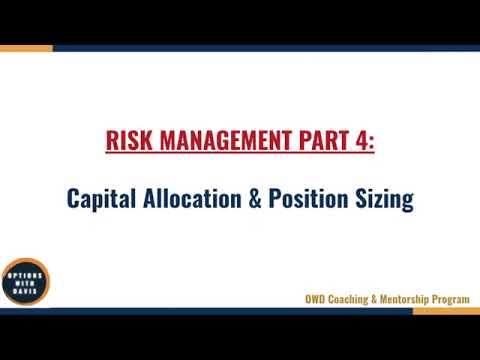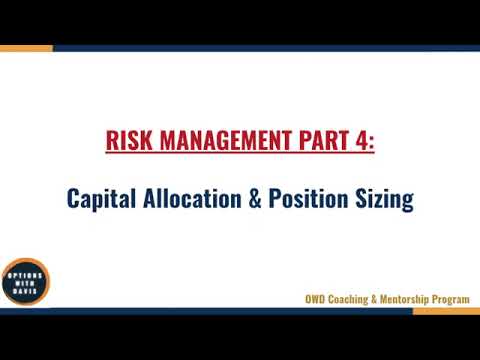In the fourth part of the risk management series, titled “2-4 Risk Management Part 4 Capital Allocation & Position Sizing,” we delve into the crucial concepts of capital allocation and position sizing in trading. One of the primary reasons new traders blow up their accounts is because they trade too large. Selling options may offer small premiums, but it also carries larger risks. It is vital to keep trade sizes small enough to withstand maximum losses. As a rule of thumb, you should allocate 5-7% of your account per trade, but this can vary based on your account size. Smaller accounts may require larger percentage allocations, while larger accounts may opt for smaller percentages. The goal is to manage risk according to your account size and the potential dollars at stake. The capital allocation strategy recommends allocating less in the markets during low volatility and more during high volatility. The allocation guideline table suggests allocating 25% of your capital during low volatility and up to 50% during high volatility. The strategy also advises having fewer trades during low volatility and more trades during high volatility, with the number of trades calculated based on the percentage of capital allocated per trade. Risk management is essential to prevent account blow-ups, with a general guideline of not exceeding 50% capital allocation at any given time, unless during high volatility periods where more capital can be allocated. Position sizing is determined by increasing the width of the spread before increasing the contract size in defined risk strategies. Examples are provided to help illustrate how to calculate contracts based on capital allocation and risk per trade.
Now, let’s dive into the nitty-gritty of capital allocation and position sizing. While it may not be the most exciting topic, it is essential to get it right, as it can determine the longevity of your trading account. One of the biggest mistakes made by new traders is trading too big, especially when selling options. Although the premium received may be small, the risk involved is significant. That’s why it’s crucial to keep trade sizes small enough to handle maximum losses. A good rule of thumb is to allocate a maximum of 5-7% per trade, but this can vary based on the size of your account. Smaller accounts may require larger percentage allocations, while larger accounts may opt for smaller percentages. The aim is to manage risk based on your account size and the potential absolute dollars at stake. The capital allocation strategy suggests allocating less capital when volatility is low and more capital when volatility is high. According to the allocation guideline table, you should allocate 25% of your capital during low volatility and up to 50% during high volatility. Moreover, the strategy recommends having fewer trades during low volatility and more trades during high volatility, with the number of trades calculated based on the percentage of capital allocated per trade. The key to risk management is to avoid exceeding 50% capital allocation at any one time, except during high volatility periods when allocating more capital might be acceptable. Position sizing should be determined by increasing the width of the spread before increasing the contract size in strategies with defined risk. By following these guidelines, you can mitigate the risk of blowing up your trading account and increase your chances of long-term profitability.

I. Introduction
Welcome to the comprehensive guide on capital allocation and position sizing in trading. In this article, we will explore the importance of these aspects in risk management and discuss various strategies to effectively allocate your capital. Understanding how to properly manage your trades and size your positions can greatly contribute to your success as a trader and prevent account blow-ups. So let’s dive in and learn how to optimize your trading approach!
II. Importance of Capital Allocation and Position Sizing
A. Capital allocation and position sizing in risk management
Capital allocation and position sizing play a crucial role in risk management for traders. By determining the amount of capital to allocate to each trade and the appropriate position size, you can protect yourself from potentially catastrophic losses. Proper risk management ensures that you can withstand the maximum loss on any single trade and continue trading without wiping out your entire account.
B. Account blow-ups due to trading too large
One of the main reasons why many new traders blow up their accounts is because they trade too large. Selling options, in particular, involves receiving small premiums but carrying larger risks. It’s essential to resist the temptation of trading as large as possible, focusing only on the potential profits. By keeping your trade sizes small enough, you can minimize the impact of a maximum loss and have the opportunity to recover and continue trading successfully.
C. Small premiums vs. larger risks in selling options
When selling options, traders receive a small premium for taking on the risk associated with the trade. It’s important to remember that the risk is often much larger than the premium received. As a result, it’s crucial to be cautious and not underestimate the potential risks involved in selling options. By sizing your positions appropriately, you can manage your risk effectively and avoid significant losses.
D. Trade sizes to withstand maximum loss
To ensure you can withstand a maximum loss on any single trade, it’s recommended to allocate a maximum of 5 to 7% of your account per trade. However, this percentage can vary depending on your account size. Larger accounts may opt for smaller percentage allocations, while smaller accounts may require larger percentage allocations. It’s crucial to determine the appropriate trade size based on your account size and potential maximum loss.
E. Account size impact on allocation percentages
The size of your account has a direct impact on the allocation percentages per trade. Smaller accounts typically require larger percentage allocations for each trade. Conversely, larger accounts can allocate a smaller percentage per trade to manage risk effectively. By adjusting the allocation percentages based on account size, you can maintain a balanced approach to capital allocation and position sizing.
III. Capital Allocation Strategies
A. Managing risk based on account size and potential dollars at stake
Managing risk based on account size and potential dollars at stake is a fundamental principle in capital allocation strategies. By understanding the relationship between your account size and the risk associated with each trade, you can determine the appropriate allocation of capital. This approach ensures that you don’t expose your account to excessive risk and can continue trading with confidence.
B. Capital allocation based on volatility levels
One effective capital allocation strategy is to adjust the allocation based on volatility levels. When volatility is low, it’s advisable to commit a lesser percentage of your overall capital to the markets. Conversely, when volatility is high, allocating a larger percentage of your capital can be beneficial. This strategy capitalizes on market conditions and adjusts your risk exposure accordingly.
C. Allocation guideline table
To provide guidance on allocation percentages based on volatility levels, a helpful allocation guideline table can be utilized. This table suggests allocating 25% of your capital when volatility is low and up to 50% when volatility is high. By referencing this table, you can quickly determine the appropriate allocation percentage for each trade, depending on the current volatility level.
D. Adjusting the number of trades based on capital allocation
Another important aspect of capital allocation is adjusting the number of trades based on the allocated capital. When volatility is low, it’s advisable to risk a smaller percentage per trade, allowing you to put on more trades on different underlying assets. Conversely, when volatility is high, a higher allocation per trade is suitable, resulting in fewer trades. Adapting the number of trades based on capital allocation ensures a balanced and calculated approach to risk management.
IV. Volatility and Position Sizing
A. Volatility’s impact on risk
Volatility plays a significant role in determining the level of risk in trading. Depending on the volatility level, the potential for large market moves and increased risk varies. It’s crucial to be mindful of volatility levels when entering trades to assess the potential risks properly. Understanding the relationship between volatility and risk is essential for effective position sizing and risk management.
B. Risk of rising volatility for option sellers
For option sellers, one of the biggest risks is low volatility that rises rapidly. This scenario indicates the potential for significant market moves that can negatively impact option positions. When volatility rises, option prices increase, resulting in potential losses for sellers. Being aware of this risk and incorporating it into your position sizing and risk management strategy is vital to protect against unexpected market movements.
C. Considering volatility levels when entering trades
Given the mean-reverting nature of volatility, it’s essential to consider volatility levels when entering trades. Volatility tends to revert to its average over time, which can impact the profitability of trades. When volatility is low, it’s advisable to be cautious and consider the potential for volatility to rise. Adjusting your position sizing and risk management based on volatility levels ensures that you are prepared for potential market fluctuations and can protect your positions effectively.
V. Position Sizing Calculations
A. Increasing spread width before increasing contract size
In defined-risk strategies, position sizing calculations involve increasing the width of the spread before increasing the contract size. This approach allows you to control risk by adjusting the spread width, rather than increasing exposure through larger contract sizes. By managing risk in this way, you can maintain a balanced and controlled approach to position sizing.
B. Maximum risk per trade and buying power requirement
Determining the maximum risk per trade and the buying power requirement of each strategy is crucial in position sizing calculations. By understanding how much you are willing to risk on each trade and the buying power required for the specific strategy, you can calculate the appropriate contract size. This calculation ensures that you are not taking on excessive risk and can manage your positions effectively.
C. Examples of contract calculation
To illustrate position sizing calculations, let’s consider an example. Suppose you risk 5% of your capital per trade. If the VIX (Volatility Index) is at 12, which indicates low volatility, the maximum number of trades you can put on at any one time is five. This is calculated by multiplying the risk percentage (5%) by the maximum allocation (25% based on the allocation guideline table). Similarly, if the VIX is at 25, allowing for higher volatility, you can allocate up to 35% of your total capital, resulting in seven trades. As the VIX exceeds 40, indicating even higher volatility, you can put on a maximum of ten trades. Adjusting the risk percentage allows for greater flexibility in the number of trades you can execute effectively.
VI. Conclusion
Understanding and implementing proper capital allocation and position sizing are essential for successful trading. By managing risk based on account size, volatility levels, and potential dollars at stake, you can protect your capital and minimize the risk of account blow-ups. By considering volatility and adjusting your positions accordingly, you can optimize your trades for potential profitability while effectively managing risk. By calculating position sizes based on maximum risk per trade and buying power requirements, you can ensure that your trades align with your risk tolerance and trading strategy. Remember, risk management is key to long-term success as a trader, and capital allocation and position sizing are powerful tools to achieve this. So, take the time to implement these strategies and trade with confidence!
